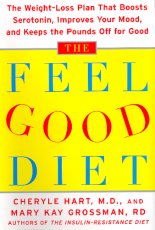 Excerpt
from The Feel-Good Diet: The Weight-Loss Plan That Boosts Serotonin, Improves Your Mood, and Keeps the Pounds Off for Good
Excerpt
from The Feel-Good Diet: The Weight-Loss Plan That Boosts Serotonin, Improves Your Mood, and Keeps the Pounds Off for Good
by Cheryle Hart, M.D., and Mary Kay Grossman, RD
Exercising Smarter
The best health and weight-loss exercise regimen includes all three methods: fat burning, cardio conditioning, and muscle building.
Fat-Burning Activity
Low-intensity activity should be done as much as possible for as long as possible. We recommend at least thirty minutes or more each day. If you are not able to get a formal metabolic-activity test, you can closely approximate your "fat-burning zone" by leisurely walking or bicycling. You will know that you have exceeded your fat-burning zone if you find you cannot
carry on a complete conversation without sounding winded. Remember that your greatest amount of fat burning occurs when you exchange the greatest amount of oxygen. Another hint that you are exercising out of your fat-burning zone is if you get hungrier after exercising. This means you were exercising in your cardio zone and used up most of your available glucose. When this happens, your brain naturally sends out the hunger message so you will eat to restore critical blood sugar levels. Most of our clients can't believe how low their heart rates have to be in order to burn the greatest amount of fat.
Cardio Conditioning
Exercises aimed at improving your heart muscle and oxygen exchange in the lungs are done to lower the amount of work it takes for your body to perform prolonged tasks. This includes the effort it takes your muscles to hold up and move your body around all day. A conditioned heart can pump more blood to your muscles. This allows you to burn more fat at lower heart rates. An unconditioned heart has to work twice as hard to pump the same amount of blood out to your muscles. Remember, the higher your heart rate climbs and the longer the duration, the more metabolic stress is placed on your body. Hormones and neurotransmitters react to this stress in ways that encourage your body to retain fat rather than burn it.
Metabolism experts advise that it is best to avoid cardio workouts on the same days you do your weight training. Both of these are considered high-intensity-type activities. When the total duration of your high-intensity activities exceeds forty minutes, they become metabolic stressors. You can minimize these negative effects by resupplying your body's glucose energy source. Eating some carbohydrates after forty minutes of high-intensity exercising keeps you from burning up muscle for energy.
A simple yet extremely effective regimen for cardio training uses the slow-fast interval method. Walk slowly and leisurely for a distance of two blocks (two-tenths of a mile) and then run all out, moving as fast as you can for one block (one-tenth of a mile). Then slow down to a walk and cool down for another two blocks. Rev up again for one block. Keep repeating these slow to fast intervals for a total of twenty minutes. Then you're done with your cardio for the day. Remember to eat a serving of carbohydrates for energy before doing high-intensity training. Drink plenty of water to stay hydrated and to avoid the metabolic stress of overheating.
Muscle Building
Muscle-building exercise allows you to burn more fat calories faster, even while sleeping. Having more muscles increases your
metabolism, which enables you to lose inches faster, eat more, and maintain your goal weight easier. This is because the more muscle you have, the more calories you use up to maintain it, even at rest.
We recommend three to four twenty- to thirty-minute training sessions a week. If you are working on all of your muscle groups each time, you should leave a twenty-four-hour break between workouts. This allows muscles time to heal, strengthen, and build. Do not let more than seventy-two hours go by without working on your muscles, or else they will start to weaken and atrophy. It is best to do twelve slow repetitions of each exercise, bringing each muscle group to fatigue.
Remember to hydrate well before, during, and after doing your weight training.
Ideally, you should work with a professional trainer to help you learn the basic techniques needed for optimal development of each muscle group. This is a valuable investment so that you get the quickest results and avoid muscle injuries. There are many good home equipment systems and video programs that will also help guide you.
Copyright © 2007 by Cheryle Hart and Mary Kay Grossman
